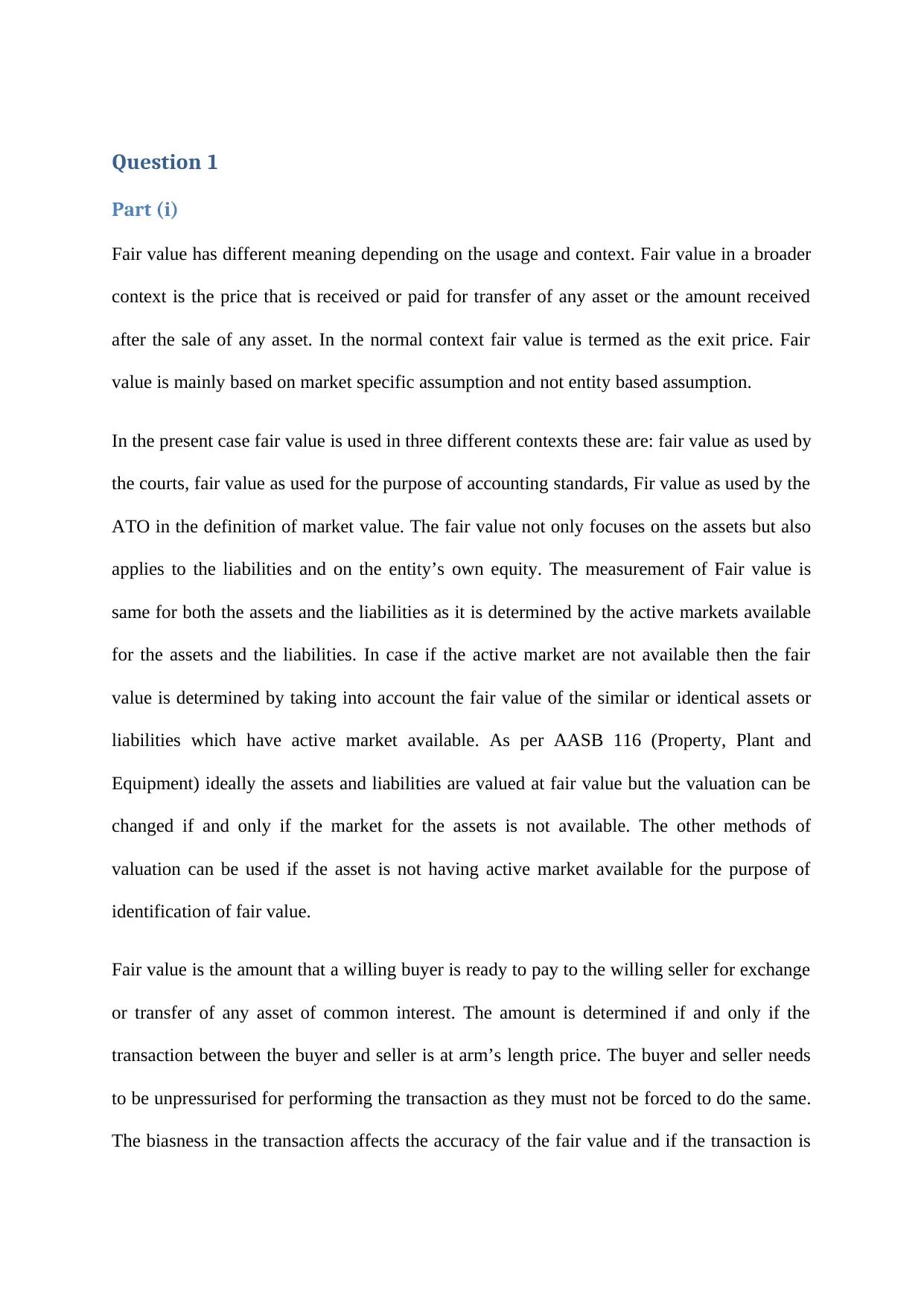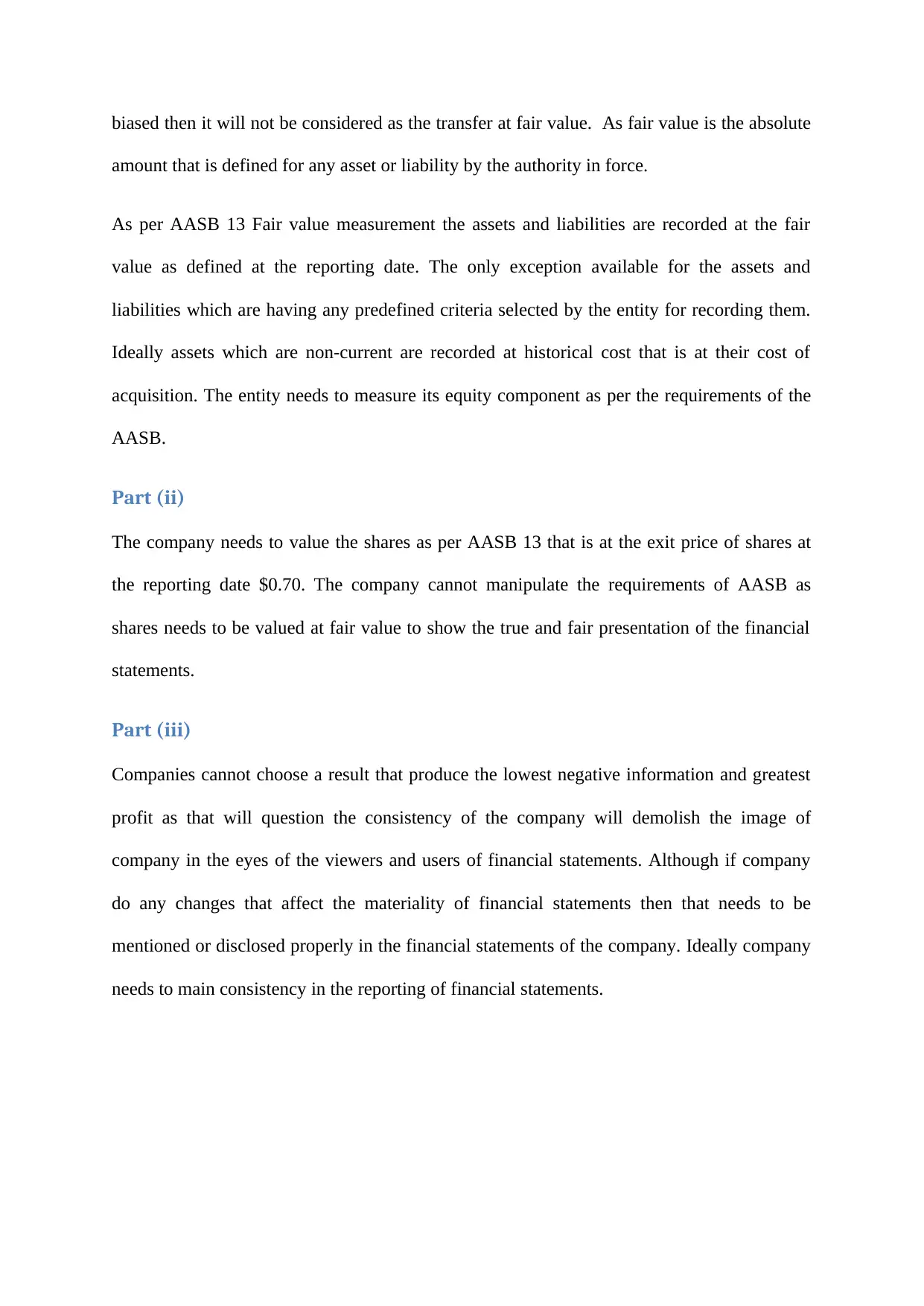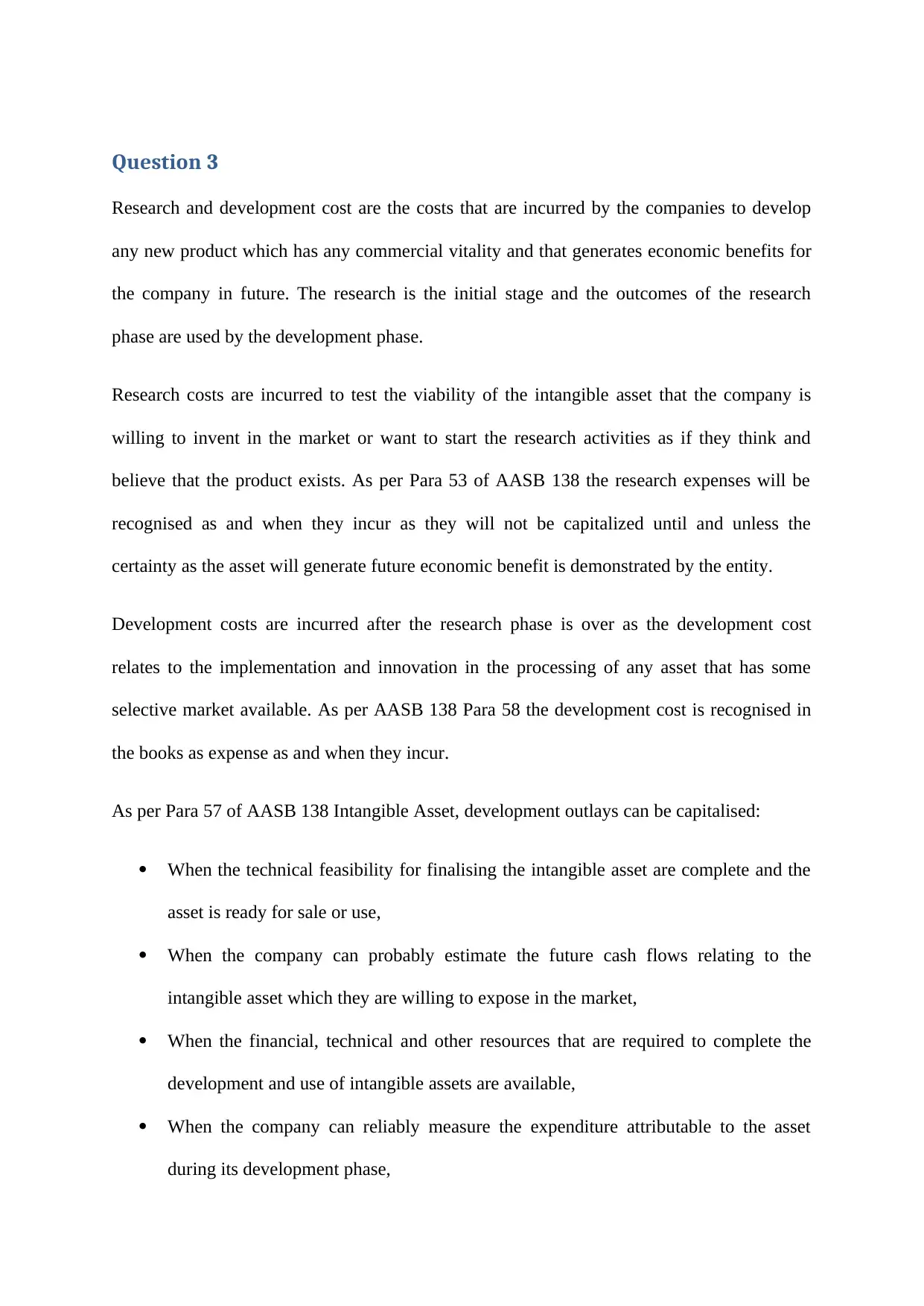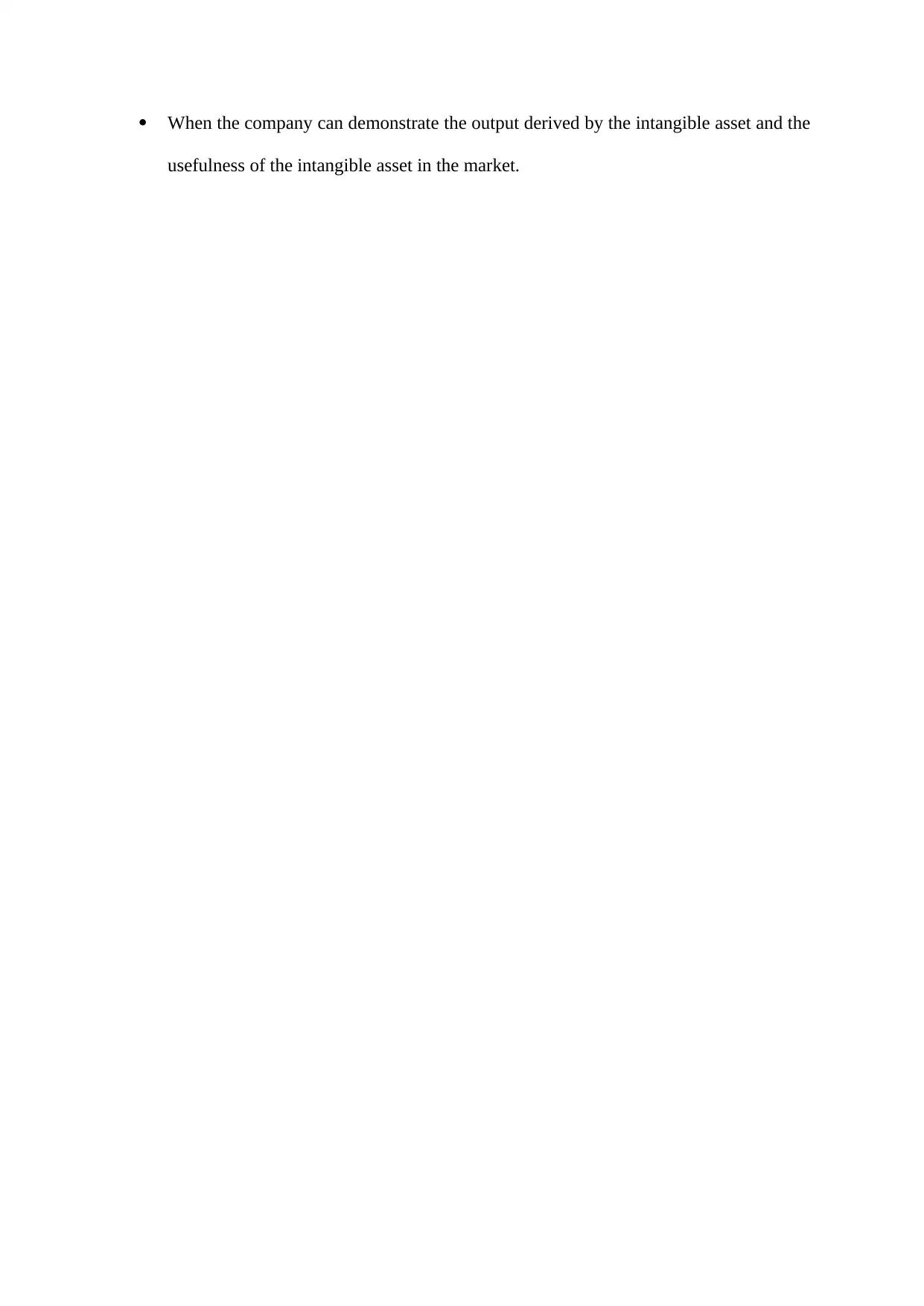ACC510 ATMC Assignment: Fair Value, AASB & Research & Development
VerifiedAdded on 2023/06/15
|4
|960
|74
Homework Assignment
AI Summary
This assignment solution addresses key concepts related to fair value, accounting standards, and research and development costs. It explains the meaning of fair value in different contexts, including its use by courts, accounting standards (specifically AASB 13), and the ATO's definition of market value. It emphasizes that fair value is market-specific and not entity-based, focusing on exit price and applying to both assets and liabilities. The solution also discusses the valuation of shares according to AASB 13 and the importance of consistency in financial reporting. Furthermore, it delves into the treatment of research and development costs under AASB 138, differentiating between research expenses (which are expensed as incurred) and development costs (which can be capitalized under specific conditions).

Question 1
Part (i)
Fair value has different meaning depending on the usage and context. Fair value in a broader
context is the price that is received or paid for transfer of any asset or the amount received
after the sale of any asset. In the normal context fair value is termed as the exit price. Fair
value is mainly based on market specific assumption and not entity based assumption.
In the present case fair value is used in three different contexts these are: fair value as used by
the courts, fair value as used for the purpose of accounting standards, Fir value as used by the
ATO in the definition of market value. The fair value not only focuses on the assets but also
applies to the liabilities and on the entity’s own equity. The measurement of Fair value is
same for both the assets and the liabilities as it is determined by the active markets available
for the assets and the liabilities. In case if the active market are not available then the fair
value is determined by taking into account the fair value of the similar or identical assets or
liabilities which have active market available. As per AASB 116 (Property, Plant and
Equipment) ideally the assets and liabilities are valued at fair value but the valuation can be
changed if and only if the market for the assets is not available. The other methods of
valuation can be used if the asset is not having active market available for the purpose of
identification of fair value.
Fair value is the amount that a willing buyer is ready to pay to the willing seller for exchange
or transfer of any asset of common interest. The amount is determined if and only if the
transaction between the buyer and seller is at arm’s length price. The buyer and seller needs
to be unpressurised for performing the transaction as they must not be forced to do the same.
The biasness in the transaction affects the accuracy of the fair value and if the transaction is
Part (i)
Fair value has different meaning depending on the usage and context. Fair value in a broader
context is the price that is received or paid for transfer of any asset or the amount received
after the sale of any asset. In the normal context fair value is termed as the exit price. Fair
value is mainly based on market specific assumption and not entity based assumption.
In the present case fair value is used in three different contexts these are: fair value as used by
the courts, fair value as used for the purpose of accounting standards, Fir value as used by the
ATO in the definition of market value. The fair value not only focuses on the assets but also
applies to the liabilities and on the entity’s own equity. The measurement of Fair value is
same for both the assets and the liabilities as it is determined by the active markets available
for the assets and the liabilities. In case if the active market are not available then the fair
value is determined by taking into account the fair value of the similar or identical assets or
liabilities which have active market available. As per AASB 116 (Property, Plant and
Equipment) ideally the assets and liabilities are valued at fair value but the valuation can be
changed if and only if the market for the assets is not available. The other methods of
valuation can be used if the asset is not having active market available for the purpose of
identification of fair value.
Fair value is the amount that a willing buyer is ready to pay to the willing seller for exchange
or transfer of any asset of common interest. The amount is determined if and only if the
transaction between the buyer and seller is at arm’s length price. The buyer and seller needs
to be unpressurised for performing the transaction as they must not be forced to do the same.
The biasness in the transaction affects the accuracy of the fair value and if the transaction is
Paraphrase This Document
Need a fresh take? Get an instant paraphrase of this document with our AI Paraphraser

biased then it will not be considered as the transfer at fair value. As fair value is the absolute
amount that is defined for any asset or liability by the authority in force.
As per AASB 13 Fair value measurement the assets and liabilities are recorded at the fair
value as defined at the reporting date. The only exception available for the assets and
liabilities which are having any predefined criteria selected by the entity for recording them.
Ideally assets which are non-current are recorded at historical cost that is at their cost of
acquisition. The entity needs to measure its equity component as per the requirements of the
AASB.
Part (ii)
The company needs to value the shares as per AASB 13 that is at the exit price of shares at
the reporting date $0.70. The company cannot manipulate the requirements of AASB as
shares needs to be valued at fair value to show the true and fair presentation of the financial
statements.
Part (iii)
Companies cannot choose a result that produce the lowest negative information and greatest
profit as that will question the consistency of the company will demolish the image of
company in the eyes of the viewers and users of financial statements. Although if company
do any changes that affect the materiality of financial statements then that needs to be
mentioned or disclosed properly in the financial statements of the company. Ideally company
needs to main consistency in the reporting of financial statements.
amount that is defined for any asset or liability by the authority in force.
As per AASB 13 Fair value measurement the assets and liabilities are recorded at the fair
value as defined at the reporting date. The only exception available for the assets and
liabilities which are having any predefined criteria selected by the entity for recording them.
Ideally assets which are non-current are recorded at historical cost that is at their cost of
acquisition. The entity needs to measure its equity component as per the requirements of the
AASB.
Part (ii)
The company needs to value the shares as per AASB 13 that is at the exit price of shares at
the reporting date $0.70. The company cannot manipulate the requirements of AASB as
shares needs to be valued at fair value to show the true and fair presentation of the financial
statements.
Part (iii)
Companies cannot choose a result that produce the lowest negative information and greatest
profit as that will question the consistency of the company will demolish the image of
company in the eyes of the viewers and users of financial statements. Although if company
do any changes that affect the materiality of financial statements then that needs to be
mentioned or disclosed properly in the financial statements of the company. Ideally company
needs to main consistency in the reporting of financial statements.

Question 3
Research and development cost are the costs that are incurred by the companies to develop
any new product which has any commercial vitality and that generates economic benefits for
the company in future. The research is the initial stage and the outcomes of the research
phase are used by the development phase.
Research costs are incurred to test the viability of the intangible asset that the company is
willing to invent in the market or want to start the research activities as if they think and
believe that the product exists. As per Para 53 of AASB 138 the research expenses will be
recognised as and when they incur as they will not be capitalized until and unless the
certainty as the asset will generate future economic benefit is demonstrated by the entity.
Development costs are incurred after the research phase is over as the development cost
relates to the implementation and innovation in the processing of any asset that has some
selective market available. As per AASB 138 Para 58 the development cost is recognised in
the books as expense as and when they incur.
As per Para 57 of AASB 138 Intangible Asset, development outlays can be capitalised:
When the technical feasibility for finalising the intangible asset are complete and the
asset is ready for sale or use,
When the company can probably estimate the future cash flows relating to the
intangible asset which they are willing to expose in the market,
When the financial, technical and other resources that are required to complete the
development and use of intangible assets are available,
When the company can reliably measure the expenditure attributable to the asset
during its development phase,
Research and development cost are the costs that are incurred by the companies to develop
any new product which has any commercial vitality and that generates economic benefits for
the company in future. The research is the initial stage and the outcomes of the research
phase are used by the development phase.
Research costs are incurred to test the viability of the intangible asset that the company is
willing to invent in the market or want to start the research activities as if they think and
believe that the product exists. As per Para 53 of AASB 138 the research expenses will be
recognised as and when they incur as they will not be capitalized until and unless the
certainty as the asset will generate future economic benefit is demonstrated by the entity.
Development costs are incurred after the research phase is over as the development cost
relates to the implementation and innovation in the processing of any asset that has some
selective market available. As per AASB 138 Para 58 the development cost is recognised in
the books as expense as and when they incur.
As per Para 57 of AASB 138 Intangible Asset, development outlays can be capitalised:
When the technical feasibility for finalising the intangible asset are complete and the
asset is ready for sale or use,
When the company can probably estimate the future cash flows relating to the
intangible asset which they are willing to expose in the market,
When the financial, technical and other resources that are required to complete the
development and use of intangible assets are available,
When the company can reliably measure the expenditure attributable to the asset
during its development phase,
⊘ This is a preview!⊘
Do you want full access?
Subscribe today to unlock all pages.

Trusted by 1+ million students worldwide

When the company can demonstrate the output derived by the intangible asset and the
usefulness of the intangible asset in the market.
usefulness of the intangible asset in the market.
1 out of 4
Related Documents
Your All-in-One AI-Powered Toolkit for Academic Success.
+13062052269
info@desklib.com
Available 24*7 on WhatsApp / Email
![[object Object]](/_next/static/media/star-bottom.7253800d.svg)
Unlock your academic potential
Copyright © 2020–2025 A2Z Services. All Rights Reserved. Developed and managed by ZUCOL.





